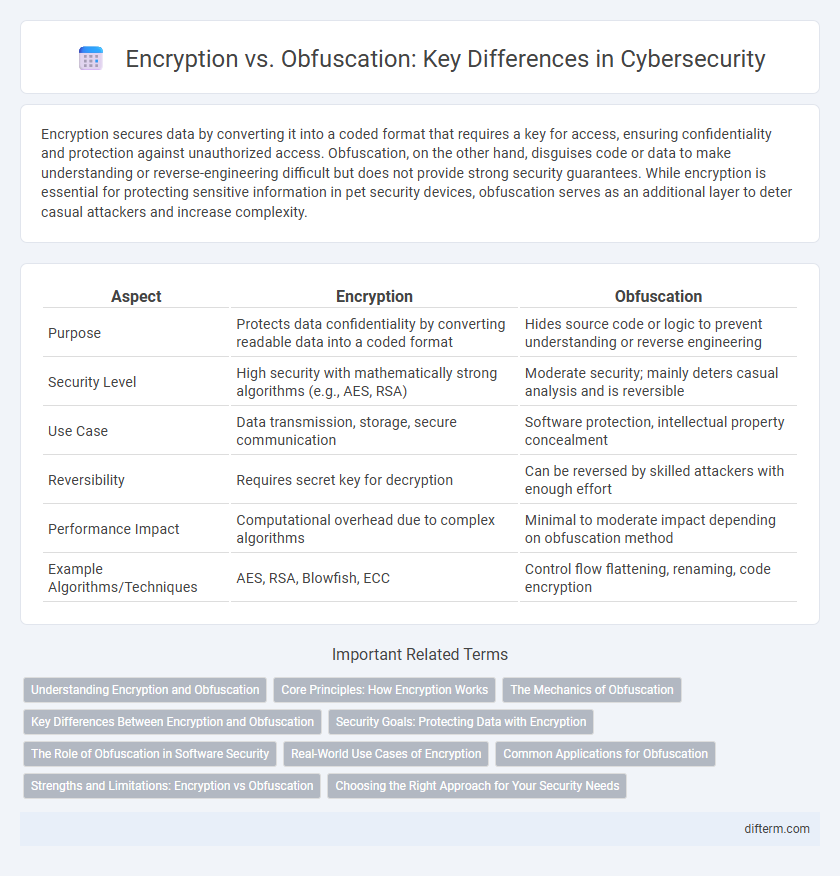Encryption secures data by converting it into a coded format that requires a key for access, ensuring confidentiality and protection against unauthorized access. Obfuscation, on the other hand, disguises code or data to make understanding or reverse-engineering difficult but does not provide strong security guarantees. While encryption is essential for protecting sensitive information in pet security devices, obfuscation serves as an additional layer to deter casual attackers and increase complexity.
Table of Comparison
| Aspect | Encryption | Obfuscation |
|---|---|---|
| Purpose | Protects data confidentiality by converting readable data into a coded format | Hides source code or logic to prevent understanding or reverse engineering |
| Security Level | High security with mathematically strong algorithms (e.g., AES, RSA) | Moderate security; mainly deters casual analysis and is reversible |
| Use Case | Data transmission, storage, secure communication | Software protection, intellectual property concealment |
| Reversibility | Requires secret key for decryption | Can be reversed by skilled attackers with enough effort |
| Performance Impact | Computational overhead due to complex algorithms | Minimal to moderate impact depending on obfuscation method |
| Example Algorithms/Techniques | AES, RSA, Blowfish, ECC | Control flow flattening, renaming, code encryption |
Understanding Encryption and Obfuscation
Encryption converts data into a coded format using mathematical algorithms and keys, ensuring confidentiality and preventing unauthorized access. Obfuscation, however, disguises the code or data to make it difficult to understand but does not provide true data protection or confidentiality. Understanding these differences is essential for implementing effective security strategies that balance data privacy and code complexity.
Core Principles: How Encryption Works
Encryption transforms readable data into ciphertext using algorithms and cryptographic keys, ensuring confidentiality by making the information inaccessible to unauthorized users. It relies on mathematical functions such as symmetric-key or asymmetric-key cryptography to secure communication and protect data integrity. The core principle involves reversible transformation, allowing only authorized parties with the correct key to decrypt and access the original information.
The Mechanics of Obfuscation
Obfuscation alters code structure to make software logic difficult to understand without changing its functionality, using techniques like control flow flattening, variable renaming, and code encryption. Unlike encryption, which secures data by transforming it into a non-readable format requiring a key for decryption, obfuscation focuses on hindering reverse engineering by increasing code complexity. Modern obfuscation tools integrate with software development processes to provide layered protection against static and dynamic analysis attacks.
Key Differences Between Encryption and Obfuscation
Encryption transforms readable data into ciphertext using cryptographic keys, ensuring data confidentiality and secure communication against unauthorized access. Obfuscation, on the other hand, disguises code or data by making it difficult to understand without altering its functionality, primarily protecting intellectual property rather than securing transmission. Unlike encryption, obfuscation does not rely on keys, making it less robust for preventing data interception or exploitation.
Security Goals: Protecting Data with Encryption
Encryption ensures data confidentiality by converting plaintext into ciphertext, making information unreadable to unauthorized users and thereby preventing data breaches. It supports integrity by detecting tampering when combined with cryptographic hashes, and enhances authentication through mechanisms like digital signatures. Obfuscation, while complicating reverse engineering, lacks the rigorous mathematical foundation of encryption and does not guarantee data confidentiality or integrity under adversarial conditions.
The Role of Obfuscation in Software Security
Obfuscation in software security serves as a crucial layer by transforming code into a complex, unintelligible format to hinder reverse engineering and unauthorized tampering. Unlike encryption, which protects data during transmission or storage through cryptographic methods, obfuscation secures the software's internal logic and intellectual property against static and dynamic analysis. This technique is especially effective in protecting proprietary algorithms and deterring attackers by increasing the difficulty and cost of exploiting vulnerabilities within the software.
Real-World Use Cases of Encryption
Encryption is widely employed in securing sensitive data in real-world applications such as online banking, where AES (Advanced Encryption Standard) safeguards financial transactions against interception. In cloud storage services, encryption protocols like RSA ensure that user files remain confidential even if the storage provider's infrastructure is compromised. End-to-end encrypted messaging apps use cryptographic keys to protect communication content, preventing unauthorized access or eavesdropping by hackers or service providers.
Common Applications for Obfuscation
Obfuscation is commonly applied in software development to protect code from reverse engineering and unauthorized access, particularly in mobile apps and proprietary algorithms. It is extensively used in JavaScript to safeguard web applications by making the source code difficult to interpret or modify. In firmware and embedded systems, obfuscation helps secure intellectual property by concealing critical logic and sensitive data from attackers.
Strengths and Limitations: Encryption vs Obfuscation
Encryption provides strong data protection by transforming information into an unreadable format using cryptographic algorithms, ensuring confidentiality and secure communication even if intercepted. Obfuscation, while not as robust, complicates reverse engineering and code analysis by making code or data less understandable without altering functionality, primarily deterring casual attackers. Limitations of encryption include computational overhead and key management challenges, whereas obfuscation's effectiveness relies on complexity and can be bypassed by skilled attackers.
Choosing the Right Approach for Your Security Needs
Encryption provides robust data protection by converting information into unreadable ciphertext, making unauthorized access nearly impossible without the decryption key. Obfuscation, on the other hand, masks code or data to deter reverse engineering but does not guarantee data confidentiality. For high-security needs involving sensitive data, encryption is the preferred method, while obfuscation is suitable for protecting intellectual property where performance and usability must be maintained.
Encryption vs Obfuscation Infographic

 difterm.com
difterm.com